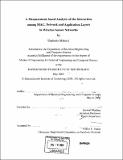| dc.contributor.advisor | Samuel Madden. | en_US |
| dc.contributor.author | Malesci, Umberto | en_US |
| dc.contributor.other | Massachusetts Institute of Technology. Dept. of Electrical Engineering and Computer Science. | en_US |
| dc.date.accessioned | 2006-07-13T15:13:02Z | |
| dc.date.available | 2006-07-13T15:13:02Z | |
| dc.date.copyright | 2005 | en_US |
| dc.date.issued | 2005 | en_US |
| dc.identifier.uri | http://hdl.handle.net/1721.1/33292 | |
| dc.description | Thesis (M. Eng.)--Massachusetts Institute of Technology, Dept. of Electrical Engineering and Computer Science, 2005. | en_US |
| dc.description | Includes bibliographical references (p. 79-83). | en_US |
| dc.description.abstract | There have been a number of recent proposals for link and network-layer protocols in the sensor networking literature, each of which claims to be superior to other approaches. However, a proposal for a networking protocol at a given layer in the stack is typically evaluated in the context of a single set of carefully selected protocols at other layers, as well as a particular network topology and application workload. Because of the limited data available about interactions between different protocols at various layers of the stack, it is difficult for developers of sensor network applications to select from amongst the range of alternative sensor networking protocols. This thesis attempts to remedy this situation by evaluating the interaction between several protocols at the MAC and network layers and measuring their performance in terms of end-to-end throughput and loss on a large, real-world TinyOS and Mica2 mote-based tested. We report on different combinations of protocols using different application workloads and power-management schemes. This thesis analyzes the effects of various services provided by the different protocols, such as link-level retransmission, neighborhood management, and link-quality estimation. Our analysis suggests some common sources of poor performance that developers may experience during real-life deployments; based on this experience, we propose a set of design principles and lessons for the designers of future interfaces and services in TinyOS. | en_US |
| dc.description.statementofresponsibility | by Umberto Malesci. | en_US |
| dc.format.extent | 83 p. | en_US |
| dc.format.extent | 3096287 bytes | |
| dc.format.extent | 3100108 bytes | |
| dc.format.mimetype | application/pdf | |
| dc.format.mimetype | application/pdf | |
| dc.language.iso | eng | en_US |
| dc.publisher | Massachusetts Institute of Technology | en_US |
| dc.rights | M.I.T. theses are protected by copyright. They may be viewed from this source for any purpose, but reproduction or distribution in any format is prohibited without written permission. See provided URL for inquiries about permission. | en_US |
| dc.rights.uri | http://dspace.mit.edu/handle/1721.1/7582 | |
| dc.subject | Electrical Engineering and Computer Science. | en_US |
| dc.title | A measurement-based analysis of the interaction among MAC, network and application layers in wireless sensor networks | en_US |
| dc.type | Thesis | en_US |
| dc.description.degree | M.Eng. | en_US |
| dc.contributor.department | Massachusetts Institute of Technology. Department of Electrical Engineering and Computer Science | |
| dc.identifier.oclc | 62278262 | en_US |
